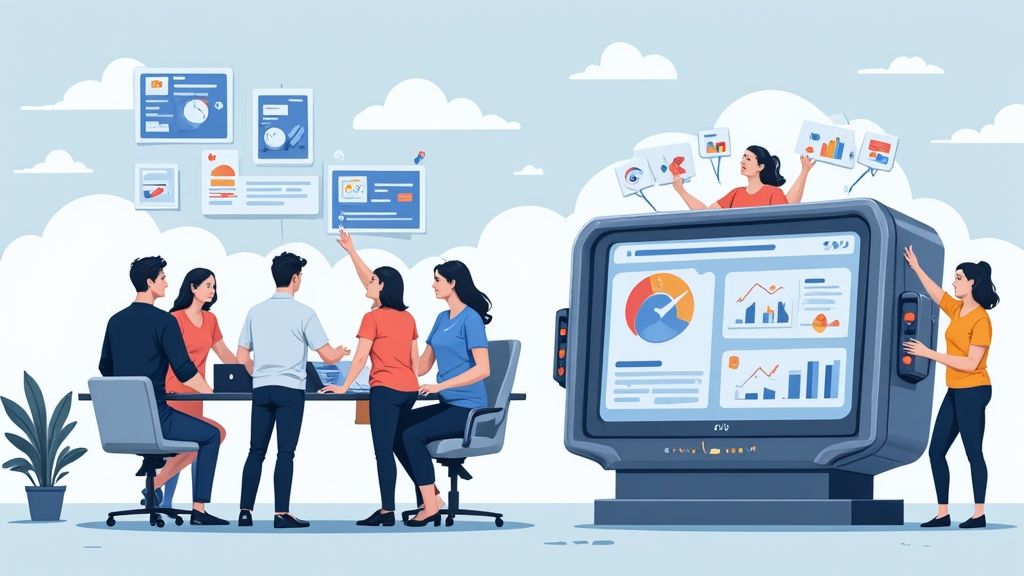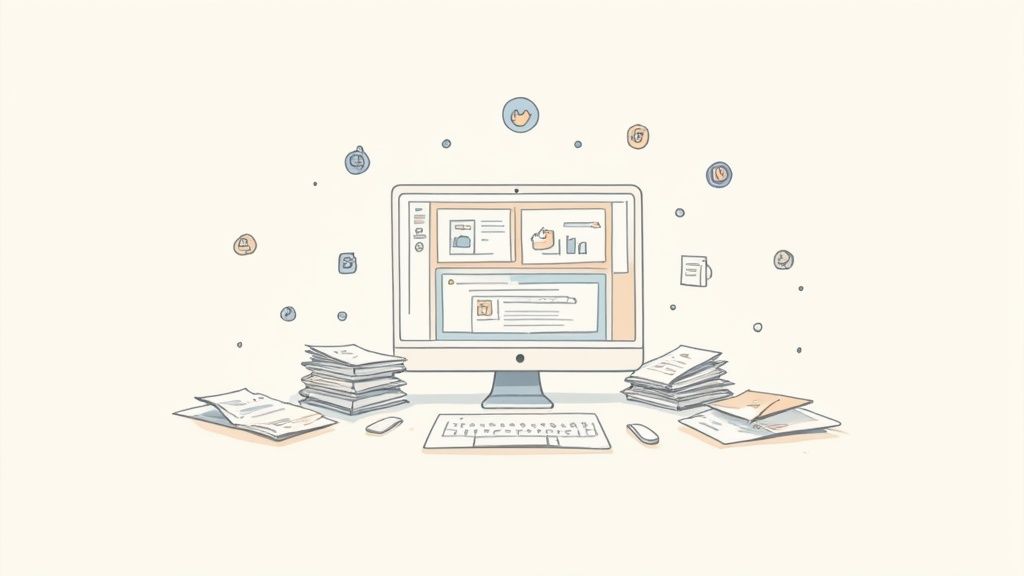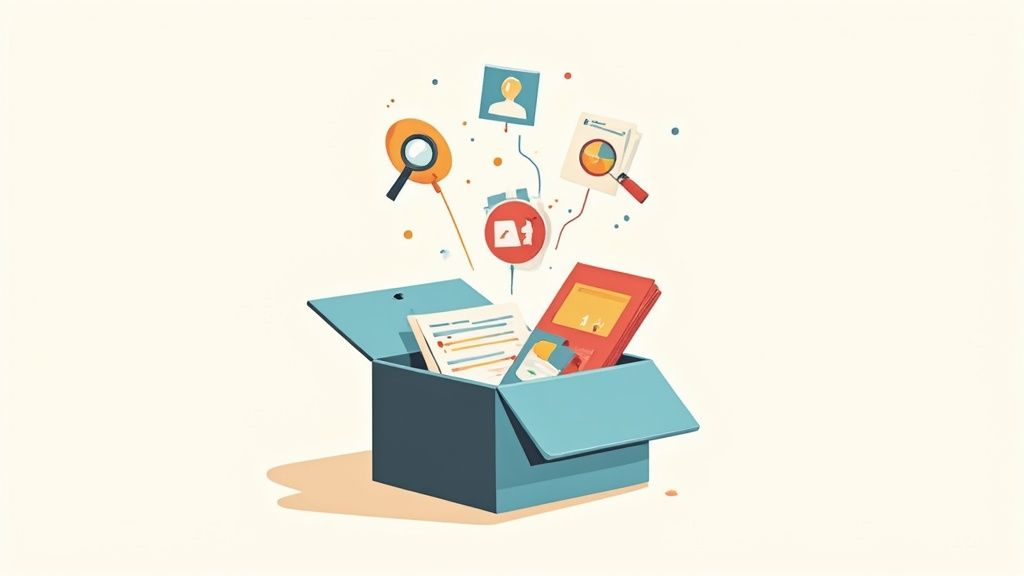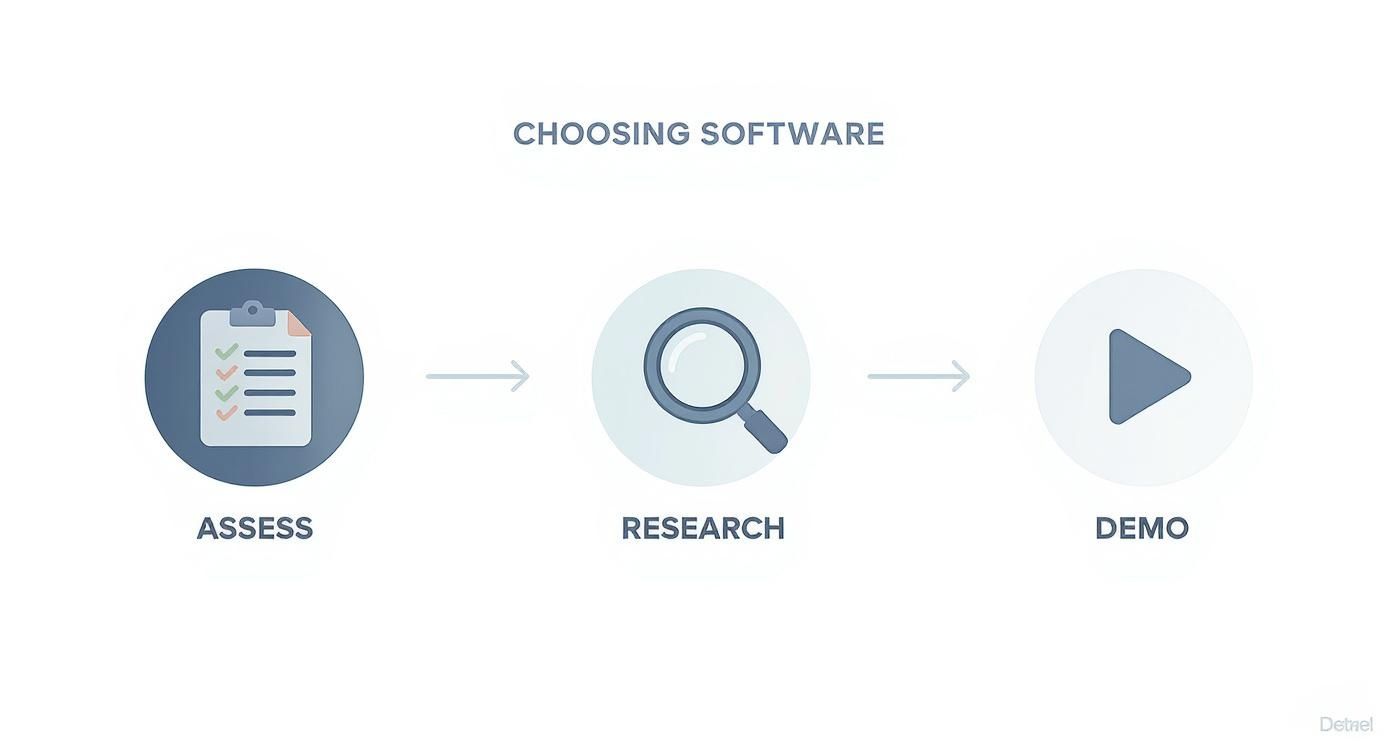Grant Management Software for Nonprofits Explained
Discover how grant management software for nonprofits streamlines funding. Learn key features, benefits, and how to choose the right platform for your mission.

Picture this: your grant information is scattered across a dozen spreadsheets, your inbox is overflowing with back-and-forth emails about deadlines, and a crucial reporting deadline is buried in a pile of paperwork on someone's desk. Sound familiar? That's the grant management chaos many nonprofits live with every day.
Grant management software for nonprofits is designed to be the antidote to that chaos. Think of it as your organization's central command center for everything related to funding. It’s a single, organized platform that brings the entire grant lifecycle—from discovery to final reporting—under one roof.
From Chaos to Control: A New Approach to Grants

For too many nonprofits, the manual approach to grants is a constant struggle. Information is siloed, deadlines sneak up on you, and pulling together a report can feel like a full-blown forensic investigation. This administrative grind doesn't just cause headaches; it pulls your talented team away from the mission-driven work they're passionate about.
This is exactly where grant management software steps in. It’s built to tame the unwieldy, multi-step process of securing and managing funding, turning it into a clear and predictable workflow. By creating a single source of truth, the software ensures everyone—from the grant writer to the program manager to the executive director—is on the same page.
Core Functions of Grant Management Platforms
At its heart, this software is all about automating and organizing the repetitive, time-consuming tasks that bog down your team. When you centralize everything, your people are freed up to think strategically instead of getting lost in administrative quicksand.
Here’s what these platforms typically handle:
- Opportunity Discovery: Helps you find and vet potential grant opportunities that actually fit your mission.
- Deadline Management: Keeps track of every single application and reporting deadline, so nothing falls through the cracks.
- Team Collaboration: Provides a shared workspace where your team can build proposals and draft reports together.
- Budget Tracking: Lets you monitor grant-specific expenses, making it easy to stay compliant with funder rules.
- Impact Reporting: Gathers your data so you can quickly build powerful reports that prove your success to funders.
The ultimate goal is to move from a reactive, chaotic process to a proactive, strategic one. This shift not only saves time but also strengthens relationships with funders by ensuring timely and accurate communication.
The Evolution of Grant Management Tools
Today's grant management platforms are a world away from the clunky databases of the past. They’ve evolved to manage the entire grant lifecycle, with a heavy focus on making the user's experience intuitive. Modern tools are expected to do it all, from helping you discover new funders to managing post-award compliance.
You'll now find features like customizable online application forms, automated eligibility screening, and robust financial tools built specifically for the unique needs of grant administrators. You can discover more about the evolution of these platforms and see just how sophisticated they've become.
The True Benefits of Grant Management Tools
Bringing grant management software into your nonprofit isn't just about buying another tool. Think of it less as an upgrade and more like installing a whole new operating system for your fundraising. It's a strategic move that pays off by making your team more efficient, keeping your reporting airtight, and ultimately, fueling your mission. The positive effects are felt at every single stage of the grant process.

This shift is more important than ever. In the United States alone, over 1.9 million nonprofits are all vying for the same limited pool of grant money. With application success rates hovering around a tough 10%, the competition is fierce. That's why so many organizations are turning to technology—it's about survival and finding an edge to manage the complexity. You can learn more about how nonprofits are leveraging technology to gain an edge.
Boost Your Operational Efficiency
Let's be honest: managing grants manually is a black hole for time. Your team spends countless hours hunting through messy spreadsheets, digging through old email threads, and chasing down documents. A good software platform puts an end to that chaos.
Everything lives in one central, organized place. Repetitive jobs like sending deadline reminders or pulling together standard application documents can be automated. This frees up your team to focus on what really matters—building relationships with funders and strengthening your programs. The result is a smoother, more collaborative workflow with far less administrative headache.
Strengthen Compliance and Reduce Risk
When it comes to grant funding, meeting every single requirement is non-negotiable. One mistake can put your funding—and your reputation—at risk. This is where grant management software becomes your safety net.
It automatically creates an audit trail for every action, conversation, and dollar spent. You'll always have the proof you need to show funders that you’re using their money exactly as promised.
By creating a single source of truth for all grant-related activities, software minimizes the risk of human error, missed deadlines, and non-compliance, thereby protecting your organization's reputation and funding.
Some of the key compliance features that make this possible include:
- Automated Deadline Alerts: The system flags upcoming application and reporting deadlines so nothing slips through the cracks.
- Centralized Document Storage: All your contracts, proposals, and financial reports are stored in one secure, searchable hub.
- Simplified Financial Reporting: Tools that connect budgets directly to grant activities make generating accurate financial reports for funders incredibly simple.
Drive Strategic Growth and Impact
Beyond just keeping things organized, the right software gives you the data you need to make smarter decisions. Built-in analytics and reporting dashboards transform your grant activities into a clear story of your impact.
This data-driven approach lets you show funders exactly what you’ve accomplished, building trust and paving the way for future support. Over time, you can see which grants are delivering the best results, helping you decide where to focus your energy to secure more—and larger—grants to grow your mission.
What to Look for: Essential Features in Nonprofit Grant Software
When you start shopping for grant management software, the list of features can seem endless. It's easy to get lost in the jargon. So, let's cut through the noise and focus on what really moves the needle for a busy nonprofit. Think of these as the non-negotiables—the core functions that will actually make your life easier.
A good platform should be the command center for all your grant activities. It's not just a digital filing cabinet; it’s an active partner that helps you stay organized, on time, and on mission.

The right set of features breaks down administrative logjams, gets your team on the same page, and, most importantly, frees you up to do the work that matters.
Centralized Management and Workflow Tools
The biggest win? Bringing order to the beautiful chaos of grant seeking. This starts with creating a single source of truth for every grant you're chasing, managing, or reporting on. No more guessing games.
Here’s what that looks like in practice:
- A Living Grant Database: This is your home base for finding and tracking funders, deadlines, and requirements. It’s what finally lets you ditch that mess of scattered spreadsheets, browser bookmarks, and sticky notes.
- Flexible Workflows: Every funder has their own quirks and requirements. Your software needs to bend with you, letting you create custom to-do lists and workflows for each specific grant application.
- One Central Document Library: Imagine a secure, cloud-based vault for every proposal draft, budget spreadsheet, and signed grant agreement. No more desperate searches through old email threads for a crucial attachment.
These tools work together to create a seamless system where everyone knows where to find what they need, right when they need it.
Automation and Tracking Capabilities
Let's be honest: manual tracking is where things fall through the cracks. Forgotten deadlines and compliance missteps are the stuff of nightmares for any grant manager. Automation is your safety net.
Think of automation as more than a time-saver—it's your risk-reduction strategy. Automating reminders, tasks, and tracking builds a reliable process that protects your funding and your nonprofit's reputation.
Your software should have smart tools that handle the busywork, including:
- Task and Deadline Management: The system should automatically create tasks from your workflows and ping team members with reminders for upcoming application and report deadlines. It’s like having a project manager who never sleeps.
- Integrated Budget Tracking: This is crucial. A great platform lets you track expenses against your grant budgets in real time. This makes financial reporting a breeze and gives you the hard data to show funders exactly how their investment is making a difference.
Many modern platforms are getting even smarter by adding a layer of artificial intelligence. To see how that's playing out, you can learn more about how organizations are using AI for grant writing and management to stay ahead.
Reporting and Analytics
At the end of the day, you need to tell the story of your impact. Strong reporting features are what turn your raw data—all those activities, numbers, and outcomes—into a powerful narrative that funders connect with.
A solid reporting dashboard lets you see key metrics at a glance, track your progress toward programmatic goals, and generate clean, professional reports with just a few clicks. This is an absolute game-changer for demonstrating your success and building the trust you need to secure that next round of funding.
To help you figure out what level of functionality you need, it's useful to see how features are typically bundled.
Comparing Grant Management Software Features by Tier
This table breaks down what you can generally expect from basic, intermediate, and advanced software tiers. Use it to gauge where your organization's needs fall.
Looking at a breakdown like this can prevent you from either overpaying for features you'll never use or choosing a tool you'll outgrow in six months. It’s all about finding that "just right" fit for where you are now and where you plan to be.
How to Choose the Right Grant Management Platform
Picking the right grant management software is a huge decision for any nonprofit. It’s not just about buying a new tool; it’s about investing in a new way of working. Get it right, and you’ll have an engine for growth. Get it wrong, and you're stuck with wasted money and a frustrated team.
Before you even think about scheduling a product demo, take a step back and look at your own house. The first move is always to understand what’s broken.
Map out your current grant process, from finding opportunities to filing the final report. Where are the bottlenecks? Are you constantly scrambling to meet deadlines? Is reporting a quarterly nightmare of spreadsheets and scattered documents? Is collaboration on a grant proposal a chaotic mess of emails and conflicting document versions? The answers to these questions will build your shopping list.
Define Your Core Needs and Priorities
You can't find the right solution until you know exactly what problem you're trying to solve. Every nonprofit is unique, so don't just grab a generic feature list off the internet. You need to figure out your must-haves versus your nice-to-haves. This clarity will be your North Star, helping you quickly weed out platforms that aren’t a good fit.
Start by asking these critical questions:
- What is our scale? A small team juggling 10 grants a year has wildly different needs than a large organization managing 100. Think about where you are now and where you want to be in three years. Your software should be able to grow with you.
- Does it play well with others? Your grant software can't operate in a vacuum. Does it need to talk to your accounting software like QuickBooks or your CRM? List your non-negotiable integrations upfront to avoid creating frustrating data islands.
- Can my team actually use it? The most powerful platform in the world is worthless if it's too complicated for your staff. A clean, intuitive interface is crucial. And don't forget about support—what kind of training and help can you expect when you get stuck?
Research and Evaluate Potential Vendors
Once you have your checklist, it's time to see what's out there. The grant management software market has exploded, driven by a growing demand for efficiency and transparency. This boom is good news for you—it means more options, from simple tools for small shops to enterprise-level systems for handling complex federal grants. You can discover more about this growing market to get a sense of the major players.
A product demo isn't just about seeing a platform's flashy features. It's about confirming that it can solve your specific, real-world problems. Walk into every demo armed with your list of needs and targeted questions.
Don't just take the salesperson's word for it. Dig deeper. Look for reviews from nonprofits of a similar size and scope. Ask for case studies. Most importantly, insist on a live demo that reflects your actual workflow, not a canned presentation. While you're at it, if you're looking to fill that new system with opportunities, explore our free grant database for nonprofits.
Ultimately, choosing a platform is about finding a partner for your mission, not just buying another piece of tech.
A Roadmap for Successful Software Implementation
Picking the right grant management software is a huge win, but the real work starts after you’ve made the choice. A great implementation plan is what turns that shiny new software into a genuine workhorse for your nonprofit. The goal? To weave the tool so seamlessly into your daily grind that your team can't imagine how they ever managed without it.
This isn't just a tech setup; it's about guiding your organization through a significant change. A smooth rollout depends on a smart strategy for moving your data, setting up your workflows, and—most importantly—getting everyone on your team genuinely excited about the shift. Let's be honest, without that buy-in, even the most powerful software will just end up collecting digital dust.
The infographic below lays out the key steps in choosing the right tool, which really sets the foundation for a successful launch.

As you can see, a great outcome starts way before the "install" button is ever clicked. It all begins with solid research, thoughtful assessment, and getting your hands dirty with a few demos.
Getting Your Team On Board
Often, the biggest challenge with new software isn't technical—it's human. We all get comfortable in our routines, and change can feel disruptive. Overcoming that hesitation comes down to two things: clear communication and finding a passionate advocate.
First, find your internal champion. This is someone on your team who is genuinely enthusiastic about the new system and what it can do. They'll become the go-to person for questions, training, and building positive energy. A recommendation from a trusted colleague often carries more weight than any announcement from leadership.
Next, you have to sell the "why" behind the change. Don’t just list features; show your team how this tool will make their specific jobs easier. Frame it as the solution to their biggest headaches, whether that's getting rid of mind-numbing data entry or taking the stress out of last-minute report pulling.
The success of your software implementation hinges on your team's adoption. By focusing on change management and clear communication, you ensure the tool is not just installed, but fully embraced.
Your Practical Implementation Checklist
To keep everything moving smoothly, it helps to break the rollout into a few manageable steps. Think of it as your launch sequence, designed to prevent overwhelm and make sure nothing important gets missed.
Data Migration and Cleanup: This is your golden opportunity for a data spring-cleaning. Before you move a single piece of information, go through your old spreadsheets and databases. Weed out duplicate entries, correct outdated info, and fix any inconsistencies. Starting with clean data is absolutely critical for getting trustworthy reports down the line.
System Configuration: This is where you make the software your own. Work with your vendor to tweak settings and workflows so they mirror how your nonprofit actually operates. The idea isn't to force your team into a rigid new process, but to shape the tool to support the great work they're already doing.
Team Training and Support: Plan for more than just a one-and-done webinar. Schedule hands-on training sessions and follow them up with ongoing support. Think cheat sheets, quick video tutorials, and regular check-ins to make sure everyone feels confident and capable. To get more ideas on building an efficient process from start to finish, check out our complete guide to grant management best practices.
Got Questions? We've Got Answers
Alright, so you've seen what grant management software can do, but a few practical questions are probably still bouncing around in your head. That's completely normal. Choosing the right software is a big deal, and it's smart to get all your concerns on the table before you move forward.
Let's cut through the sales talk and tackle the most common questions we hear from nonprofits. The goal here is to give you straightforward, honest answers so you can make a confident decision.
What's This Going to Cost Us?
This is usually question number one, and the honest answer is: it depends. The pricing is a lot like a subscription service—think Netflix, but for your grants. For a small nonprofit just getting started, you might find basic plans in the $50-$100 per month range. For larger organizations juggling dozens of complex grants, the price can climb to several hundred or even thousands per month.
The great thing is that the subscription model means you don't have to sink a huge amount of cash upfront. When you're budgeting, just make sure to ask about the total cost. Are there one-time setup fees? What about training for your team? The trick is to balance this cost against the massive amount of time you'll save on admin tasks and the potential for winning more grants.
Will This Play Nicely With Our Other Software?
It absolutely should. Any grant management software worth its salt is built to connect with the other tools you rely on, not trap your data on an island. You want a team player, not a lone wolf.
Look for key integrations with the systems you already use:
- Accounting Software: Imagine your grant financials syncing directly with platforms like QuickBooks. No more manual data entry for expense tracking.
- Donor Management/CRMs: If you use a CRM like Salesforce, connecting it to your grant software means you aren't duplicating contact info and funding history.
Before you even look at demos, make a quick list of your must-have tools. Then, when you're talking to vendors, you can ask them directly if they integrate or if they can connect through a tool like Zapier. A connected tech stack is an efficient one.
How Hard Is This to Learn? My Team Isn't Super Techy.
This is a valid concern, but most modern platforms are designed with real, busy people in mind. They focus on clean dashboards, simple navigation, and workflows that guide you through the process. The learning curve really depends on two things: how comfortable your team is with technology in general and how complex the system is.
The best way to know for sure is to get your team's hands on it. Don't just watch a demo—ask for a free trial. Let the people who will be using it every day click around and tell you what they think. Their feedback is gold.
And don't just evaluate the software; check out the support behind it. Does the company offer solid training videos, a helpful knowledge base, and real human beings you can talk to? Good support can make all the difference in helping your team feel confident from the get-go.
How Does This Actually Make Funder Reporting Easier?
This is where the magic really happens. Instead of a last-minute scramble digging through spreadsheets, emails, and random documents, all your grant information lives in one organized place. We're talking financials, program updates, outcome metrics—everything.
When a reporting deadline looms, you can pull a professional, accurate report in just a few clicks. Many platforms even have templates that are already set up to meet common funder requirements. Because you’re tracking your spending and progress in real-time, you can deliver timely, transparent reports that show funders you’re on top of your game. That’s how you build trust and keep the funding relationship strong.
Ready to transform your grant management process from chaotic to controlled? Fundsprout uses AI to help you find the perfect grants, write winning proposals, and manage compliance effortlessly. Discover how Fundsprout can fuel your mission.
Try 14 days free
Get started with Fundsprout so you can focus on what really matters.
